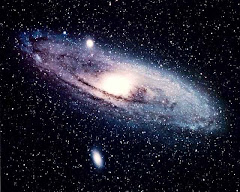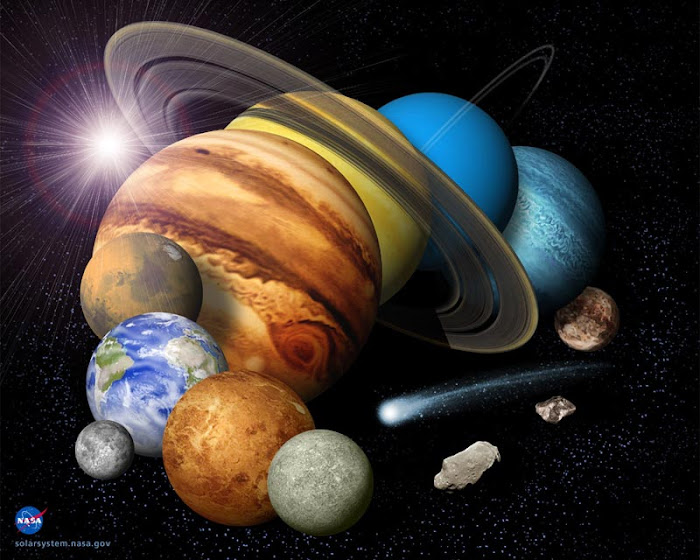 Did you ever notice that the Moon always looks the same? Sure, it waxes and wanes from a new moon to a full moon, but the bright and dark patches on the Moon always look the same. In fact, these features are so familiar that people call it the Man in the Moon.
Did you ever notice that the Moon always looks the same? Sure, it waxes and wanes from a new moon to a full moon, but the bright and dark patches on the Moon always look the same. In fact, these features are so familiar that people call it the Man in the Moon.
This is because the Moon always points the same face towards the Earth. The Moon does actually rotate on its axis, it's just that the amount of time it takes to make a complete orbit around the Earth matches the amount of time it takes to complete one rotation. In both cases, this is 27.3 days.
So, when you hear people refer to the far side of the Moon, they're talking about the part of the Moon that always faces away from the Earth. Until we sent spacecraft into orbit around the Moon to take pictures, nobody on Earth had ever seen what the far side of the Moon looks like.
But why does this happen? Over the few billions years since its formation, the Moon has become tidally locked with the Earth. In the distant past, the Moon had different rotation and orbital speeds, and it showed all of its sides to our planet. But the gravity of the Earth tugged at the irregular shapes on the Moon, causing it to slow its rotation down until it was exactly the same length as its orbit.
The Earth, on the other hand, has so much mass that the force of gravity from the Moon pulling on Earth can't overcome its rotational speed. The Moon does create the tides, though, and causes the ground to rise and fall - it's just such a small amount that you can't feel it.
Sometimes people mistakenly call this the dark side of the Moon. But there is no dark side of the Moon. Think about it, when we're seeing a new moon, that's because the familiar part that we can always see is in shadow. But at that point, the far side will be bathed in sunlight.
Tuesday, July 8, 2008
The Moon
How Does the Earth Protect Us From Space?
 Answer: Our Earth keeps us very safe from a dangerous Universe that's always trying to kill us in new and interesting ways.
Answer: Our Earth keeps us very safe from a dangerous Universe that's always trying to kill us in new and interesting ways.
Risk: Cosmic rays are high energy particles fired at nearly the speed of light by the Sun, supermassive black holes and supernovae. They have the ability to blast right through your body, damaging DNA as they go. Long term exposure to cosmic rays increases your chances of getting cancer. Fortunately, we have our atmosphere to protect us. As cosmic rays crash into the atmosphere, they collide with the oxygen and nitrogen molecules in the air.
Risk: Gamma rays and X-rays. As you know, radiation can damage the body. Just a single high-energy photon of gamma rays can cause significant damage to a living cell. Once again, though, the Earth's atmosphere is there to protect us. The molecules in the atmosphere absorb the high-energy photons preventing any from reaching us on the ground. In fact, X-ray and gamma ray observatories need to be built in space because there's no way we can see them from the ground.
Risk: Ultraviolet radiation. The Sun is bathing the Earth in ultraviolet radiation; that's why you get a sunburn. But the ozone layer is a special region of the atmosphere that absorbs much of this radiation. Without the ozone layer we would be much more exposed here on the surface of the Earth to UV rays, leading to eye damage and greater incidence of skin cancer.
Risk: Solar flares. Violent explosions on the surface of the Sun release a huge amount of energy as flares. In addition to a blast of radiation, it often sends out a burst of plasma traveling at nearly the speed of light. The Earth's magnetosphere protects us here on Earth from the effects of the plasma, keeping it safely way from the surface of the planet. And our atmosphere keeps the X-ray/gamma ray radiation out.
Risk: Cold temperatures. Space itself is just a few degrees above absolute zero, but our atmosphere acts like a blanket, keeping warm temperatures in. Without the atmosphere, we'd freeze almost instantly.
Risk: Vacuum. Space is airless. Without the Earth, there'd be no air to breath, and the lack of pressure damages cells and lets water evaporate out into space. Vacuum would be very, very bad.











